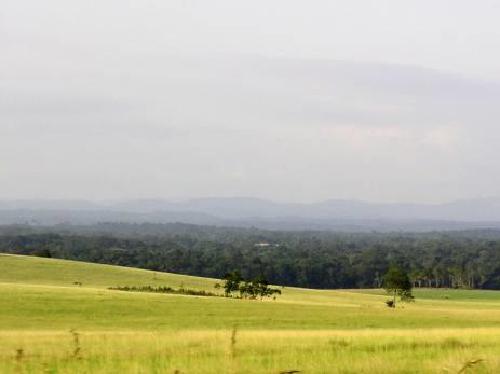Michelle Wieland
This project examines bushmeat hunting through the use of social and ecological methods to better understand the complex factors that contribute to local wildlife declines in central Africa.

Conkouati's mix of savanna and forest habitats.
Considerable pressure on wildlife in tropical forests arising from political instability, population growth, and international exploitation of natural resources has resulted in declining wildlife populations. Central Africa is a marked example of this, where the strain on wildlife is exacerbated by an increased consumption of bushmeat by people living in densely populated cities. These mammals are not only important for maintaining biodiversity and forest ecosystems, but also play a major economic and dietary role for many rural families. This study uses both social and ecological methods to improve our understandings of the tenuous social and economic complexities that often elude ecologically oriented conservation initiatives to protect wildlife populations.

Bushmeat collector discussing data.
This research project focuses on Conkouati National Park in southern Congo; a relatively new and unique protected area that includes 2500 inhabitants, many of whom depend on wildlife for their livelihoods. It consists of concurrent studies on hunted wildlife populations, bushmeat consumption, and various stakeholder values and uses of the environment. This includes a relative abundance study of hunted wildlife species inside the national park. The social component of this research includes semi-structured interviews with government, industry, and villagers to explore cultural and economic importance of the environment, especially wildlife. In addition, a year long study of food consumption in three selected park villages with different livelihood strategies examines seasonal variation in diet, as well as a comparison of bushmeat consumption between fishing and hunting villages.
The objectives are to:
1) Develop a methodology to examine hunted mammal populations in equatorial forests;
2) Present a park management tool to gauge the effectiveness bushmeat trafficking laws;
3) Explore human influences on mammal distributions, such as proximity to villages and poaching, fishing and gold mining camps;
4) Examine before and after effects on wildlife abundance from a newly initiated oil exploration and extraction permit inside the national park;
5) Quantify the consumption of wildlife and other natural resources in local diets;
6) Contribute to skills development of and opportunity for Congolese researchers.
Government and conservation organizations strive to protect wildlife populations at Conkouati, yet are challenged daily by humans whose livelihoods are currently dependent on these populations. Villagers in the area do not want to be dependent on wildlife, and this study will help them examine their own consumption patterns and provide a tool to develop other sources of income and food security. At the same time this research will help conservationists to better understand local people and provide valuable wildlife monitoring tools.